|
|
| Home - Software M&A Review |
Software M&A - Q1 Software Industry Equity Report
continued... page 2 |
MERGERS AND ACQUISITIONS: THE NUMBERS
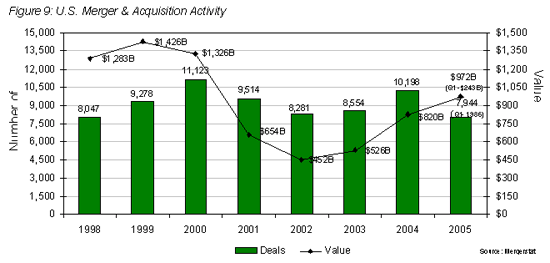
The momentum of 2004’s U.S. merger and acquisition activity slowed in 1Q05. Domestic M&A activity across all industry sectors in the first quarter totaled 1,986 deals with an aggregate purchase price of $243 billion (Figure 9). The total number of deals in 1Q05 declined 10.5% from 1Q04, while total M&A dollars for 1Q05 dropped 18% from Q4 2003, already 56% of 2003’s total. However, if current U.S. M&A activity remains constant, 2005 will yield an 18.5% increase in total deal value spread across 22.1% fewer deals.
Software mergers and acquisitions continued to lead all other industry sectors with 371 deals. This is the fourth successive decline in software industry M&A deal volume since the number of transactions reached a three year high in 2Q04 (Figure 10). In terms of aggregate purchase price, the $21.5 billion spent on software company acquisitions in 1Q05 was up 70.6% from 1Q04 (Figure 11). Three mega deals (Buyout firms Silver Lake, et. al./SunGard; InterActiveCorp/Ask Jeeves; and IBM/Ascential) made up more than half the total deal value.
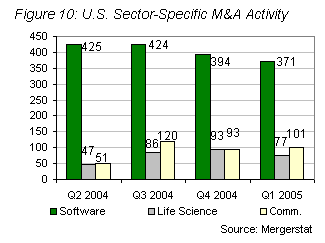
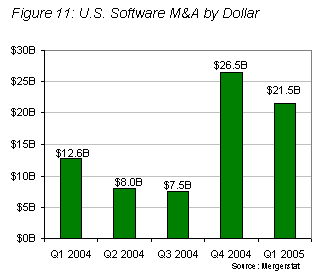
Median exit valuations declined as they often do in the first quarter, but remained slightly above historical norms. The median software company M&A valuation (based on equity purchase price), reached 2.1 times trailing-twelve-months (TTM) revenue in 1Q05, a 9.5% decline from the median M&A valuation of 2.3x in 1Q04 and a 25% decline from 4Q04’s 2.8x median valuation (Figure 12).
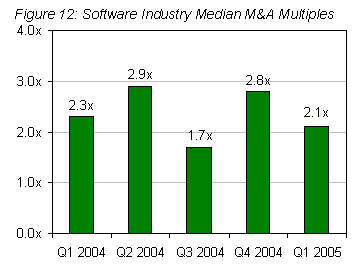
The erratic stock market and healthy buyer balance sheets made cash, once again, the preferred form of deal consideration. 61% of buyers in 1Q05 used cash – up from 51% a year ago, but on par with last quarter. Concomitantly, 17% of buyers in 1Q05 paid all stock (vs. 22% in 1Q04) and 22% used a combination of cash and stock (vs. 27% in 1Q04).
MERGERS AND ACQUISITIONS: BUYER MOTIVES
In order to discern trends in merger and acquisition activity, it is essential to understand changes in buyer thinking. Precisely what motivated the buyer to acquire this particular company; to spend cash, dilute equity, allocate precious resources and assume sometimes formidable risks? What were the deal drivers in 1Q05, how were they different from previous quarters and how did they impact valuations and purchase prices?
Product Extension
A deal-by-deal analysis of the 208 software transactions we analyzed in 1Q05 reveals 46% of the buyers sought to enhance their current product suite by acquiring small and mid-cap companies targeting the same markets with highly complementary, best-of-breed, market proven products and technology (Figure 14). Their objective was to better satisfy market requirements and thereby differentiate from the competition and create new sources of revenue. Sellers deemed to be a product extension commanded the highest multiple compared to our other categories with a 4.0x. Examples include IBM’s acquisition of data integration provider Ascential to beef up IBM’s rapidly growing information integration business; Oracle’s triumph over SAP in purchasing of Retek, a developer of best-of-breed point-of-sail and supply chain management solutions to the retail vertical; and Verisign’s acquisition of Lightsurf, a solution provider in the growing and still immature mobile content management market.
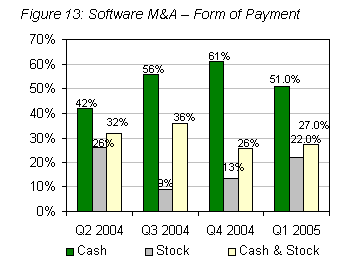
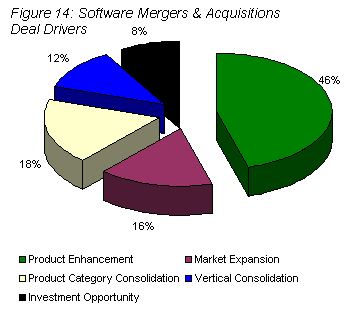
Market Expansion
16% of buyers (vs. 20% in 4Q04) ventured further from home, acquiring software companies in new product categories and new geographic and vertical markets in an effort to accelerate growth. New market buyers included The Sage Group, a leading provider of small and midmarket accounting software, which acquired Symfonia, a Polish software provider serving Eastern Europe. WebSideStory, a provider of marketing and research analytics, acquired Avivo, developer of content management software. Investment banking powerhouse J.P. Morgan acquired global trade management provider Vastera. Product lifecycle management provider Agile, acquired Cimmetry to gain access to the manufacturing, electronics, architecture/engineering/construction
(A/E/C) and industrial markets. Market expansion deals had a median multiple of 1.3x in the first quarter, lower than typical for this category, mostly because these were smaller transactions with smaller sized buyers and sellers.
Vertical Markets
Vertical market software company acquisitions comprised about 12% of M&A transactions in 1Q05 compared to 6% in 4Q04. Vertical market buyers paid a median 3.0x TTM multiple, mostly for products and enabling technology that would extend their product lines and provide competitive differentiation. As in 2004, healthcare was the most active software M&A vertical market. Merge Technologies, a developer of picture archiving and communications systems for hospital information systems, merged with Cedara, a developer of medical imaging technologies. Elekta, a Swedish provider of radiation technology, acquired IMPAC, a provider of clinical and administrative management systems for cancer care facilities, for $250 million. 1Q05 also saw software acquisitions in the government, legal and financial sectors.
Product Category Consolidation
The first quarter saw a sharp increase in consolidation plays, the buyout of a software company by a larger software company (most often a competitor) to gain market share and eliminate competition. With IT budgets flat and investors and analysts clamoring for top line growth, consolidation became the preferred means to acquire new customers in 1Q05. Median consolidation deal multiples were a low 0.8x, nor surprising when IP is secondary or superfluous, and the reaction of the seller’s customer base is uncertain. Infor Global Solutions, a privately held enterprise resource planning provider to manufacturing customers, acquired Mapics to gain revenue and market share. UGS did the same in the product lifecycle management category by acquiring Tecnomatix, as did workforce management leader Saba in acquiring Thinq.
Investment Opportunity
Almost one in three software company buyers in 1Q05 were private. Most were venture-backed private software companies using VC cash as currency. Venture capitalists and private equity firms also acquired directly. First-party private equity deals accounted for 9% of all software M&A transactions and had a median multiple of 1.9x. The largest direct investment deal this year ($11.3 billion) was the acquisition of Sungard, a leading solutions provider to the financial services sector, by a consortium of buyout firms led by Silver Lake Partners. Golden Gate Capital took a bet on the battered customer relationship management category, buying Blue Martini Software for $54 million.
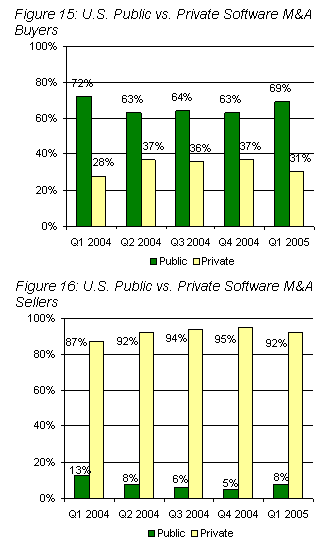
...more...

|
|


|

